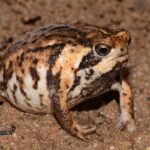Brachycephalus puri: Exploring the Tiny Wonders of the Brazilian Atlantic Forest#
Hidden deep within the lush, verdant landscapes of Brazil’s Atlantic rainforest lies a remarkable creature whose presence delights herpetologists and nature enthusiasts alike. No bigger than a thumbnail, yet exuding charm far beyond its size, the tiny Brachycephalus puri captures the imagination at first glance. Commonly referred to as Puri’s Pumpkin Toadlet, this diminutive amphibian paints the forest floor in subtle splashes of vibrant color and represents one of the innumerable marvels inhabiting this threatened ecosystem.
First described scientifically in 2018, Brachycephalus puri exemplifies the captivating biodiversity of the Atlantic forest—an ecosystem renowned for its astonishing richness yet imperiled by human activity. Despite its recent discovery and miniature stature, this frog has quickly become a focal point for conservationists eager to preserve the intricate web of life teeming beneath the tropical canopy.
Taxonomy and Classification#
Belonging to the family Brachycephalidae, the genus Brachycephalus boasts a remarkable diversity of small-bodied frogs endemic to the Brazilian Atlantic forest biome. Known commonly as “Pumpkin Toadlets” due to their vivid, orange-hued skin and beaded bodies, members of this genus occupy narrow ranges that frequently limit their existence to isolated mountaintops or valleys, supporting unique evolutionary trajectories.
Brachycephalus puri was formally described from specimens collected near Morro do Puri in the municipality of Barra do Piraí, located in the state of Rio de Janeiro, Brazil. The species epithet “puri” honors the indigenous Puri people historically inhabiting this region, a nod toward respecting traditional communities closely interconnected with these forested ecosystems.
Closely related to other micro-endemic representatives of its genus, such as Brachycephalus ephippium and Brachycephalus pitanga, B. puri contributes significantly to our understanding of speciation and adaptation in isolated habitats.
Natural Habitat#
The Atlantic forest of Brazil, known locally as Mata Atlântica, serves as the exclusive home for Brachycephalus puri. Characterized by its humid, subtropical climate, dense vegetation, and plentiful rainfall, this biome represents an ideal environment for the specialized existence these frogs lead.
Geographic Range and Distribution#
Brachycephalus puri has thus far been documented solely from a single locality—the particular mountaintop from which it was first identified, Morro do Puri, at elevations of approximately 800 to 900 meters above sea level. Such extremely limited distribution increases its vulnerability to habitat alterations, highlighting the delicate balance required for its survival.
Microhabitat Preferences#
Inhabiting the leaf litter of cloud forests, these frogs flourish in damp, shaded conditions beneath the understory. Thick layers of foliage, moss-covered logs, and lush ferns create critical habitat structures. The dense leaf-litter provides shelter against predation, fluctuating temperatures, and moisture stress, critical factors given their permeable amphibious skin and micro-scale anatomy.
Small streams and seepages that maintain a consistently high humidity provide the necessary microclimate for egg development, freeing these frogs from direct reliance on large bodies of standing water, unlike their larger amphibian cousins. As climate patterns shift and deforestation encroaches further into these pristine environments, these intricate habitat elements are increasingly threatened, presenting daunting conservation challenges.
Physical Characteristics#
The first and most striking feature of Brachycephalus puri is undoubtedly its diminutive stature. Measuring a mere 9 to 12 millimeters from snout to vent, this species figuratively and literally blends seamlessly into its forest realm. Yet, despite—or because of—its minuscule size, detailed observation reveals remarkable adaptations.
The body coloration varies from bright oranges and yellows to shades of amber, sympathetically matching fallen leaves. Tiny bones become visible through semi-translucent skin—a trait enhancing cryptic coloration essential for survival in their leafy habitat. Their backs exhibit a grainy or rugged texture, further assisting in camouflage among debris covering the forest floor.
Perhaps most intriguing is the internal feature known as “hyperossification,” where certain skeletal elements fuse or thicken, a trait common in Brachycephalus species. This specialization hints at evolutionary strategies minimizing water loss and aiding predator deterrence. Moreover, their reduced fingers and toes reflect a specialized lifestyle entirely removed from climbing or swimming, emphasizing adaptation to terrestrial life amidst leaf litter.
Behavior and Life Cycle#
Behaviorally, these elusive creatures lead solitary, hidden lives. By day, they remain largely inactive, maintaining moisture beneath cooler leaves and logs. During humid evenings or rain episodes, however, they spring to life in subtle yet captivating displays of activity—slowly shifting positions, quietly searching for prey like mites, ants, and springtails among the leaf litter.
Unique Breeding Practices and Development#
Unlike many frogs requiring aquatic environments for reproduction and larval growth, Brachycephalus puri has developed terrestrial egg-laying strategies. Females lay small batches of eggs directly within moist leaf litter or hidden crevices. These eggs bypass the traditional aquatic tadpole stage entirely, developing directly into miniature versions of adults. This reproductive adaptation significantly reduces dependence on standing water, freeing the species from competition found in larger waterbodies and enhancing survival chances in their isolated habitats.
Males produce faint clicking calls to attract females, a subtle, localized means of communication adapted to the dense forest underlayers. This quiet courtship maintains a low profile, limiting predator attraction. Intriguingly, recent research suggests that certain closely related species within Brachycephalus may lack fully functional hearing, relying instead on vibrational cues or extracolumnellar auditory mechanisms—another fascinating evolutionary adaptation warranting further inquiry for B. puri specifically.
Ecological Role#
Despite their minuscule size, Brachycephalus puri plays vital ecological roles within its microhabitat. Acting primarily as insectivorous predators, their presence helps regulate populations of tiny invertebrates. By controlling these populations, these tiny frogs indirectly influence nutrient cycling, soil health, and vegetation growth across their diminutive sphere of influence.
Additionally, as prey for spiders, birds, and larger frog species, these creatures become integral participants in the broader food web. Furthermore, their sensitivity to environmental changes positions them as valuable indicator species—invaluable living alarms signifying ecological disturbances often otherwise unnoticed by scientists until consequences are severe.
Threats and Conservation Status#
The limited geographic range and specialized habitat requirements of Brachycephalus puri inherently amplify conservation concerns. Deforestation, urban expansion, agriculture, and climate change represent primary threats, each steadily destabilizing fragile habitats critical for survival. Habitat fragmentation restricts gene flow between populations, negatively impacting genetic diversity and adaptability over generations.
Although not yet assessed formally for an official IUCN status due to the species’ recent discovery, conservation biologists recognize it as a vulnerable or potentially endangered species due to its highly restricted distribution, life-history traits, and habitat vulnerability. Conservation initiatives now prioritize habitat preservation, responsible eco-tourism management, and public awareness campaigns illustrating the need to protect Brazil’s unique amphibian biodiversity.
Cultural and Scientific Significance#
Beyond ecological value, Brachycephalus puri holds cultural and scientific importance. Its name acknowledges indigenous communities deeply connected to Brazilian forests—a gentle reminder of the cultural heritage intertwined with biodiversity. Scientifically, these frogs provide windows into evolutionary biology, studying rapid speciation mechanisms and morphological adaptations unique to condition-specific environments.
Conclusion#
Hidden beneath Brazil’s Atlantic forest canopy, the tiny yet extraordinary Brachycephalus puri embodies the wonder of nature’s capacity for adaptation and diversity. Yet its delicate existence underscores urgent conservation realities, reminding us of our collective responsibility toward preserving intricate ecosystems harboring spectacular biodiversity like this tiny frog.
Our call to action is clear: to ensure these special creatures continue capturing human curiosity, fostering deeper connections between science, community, and conservation through education, responsible stewardship, and sustainable coexistence.







